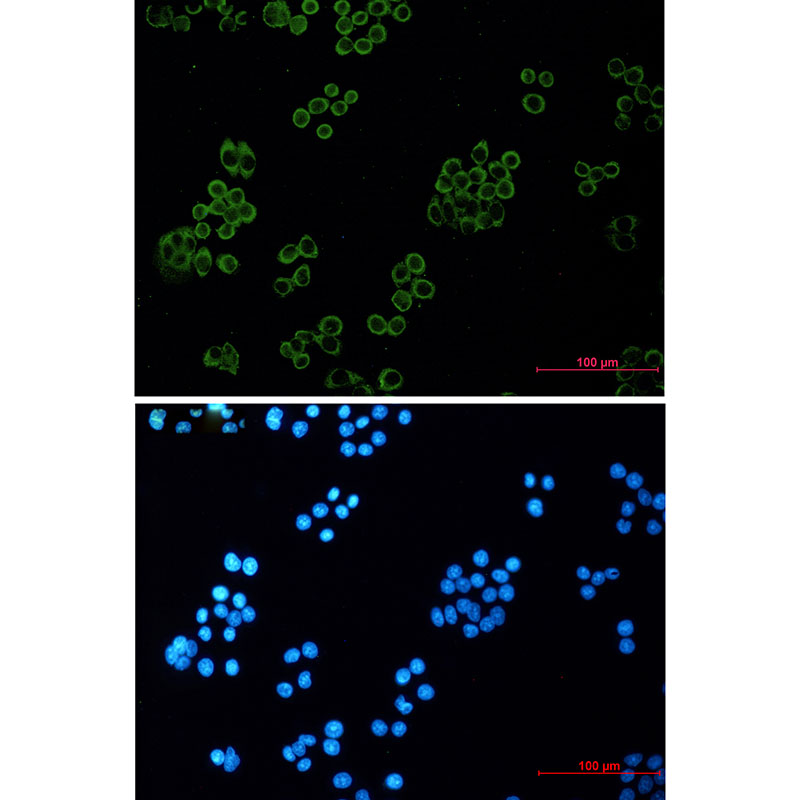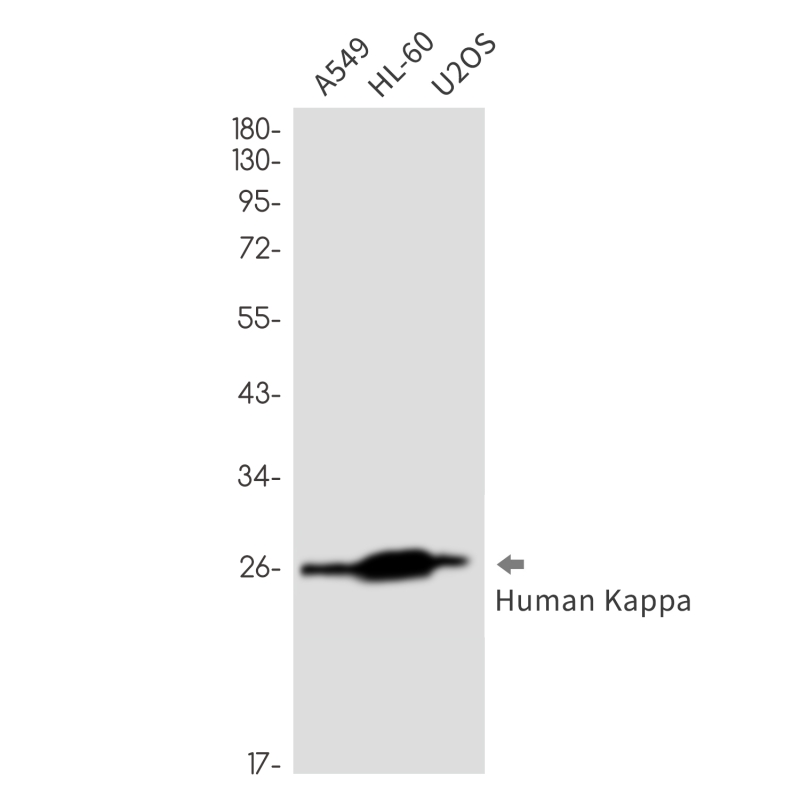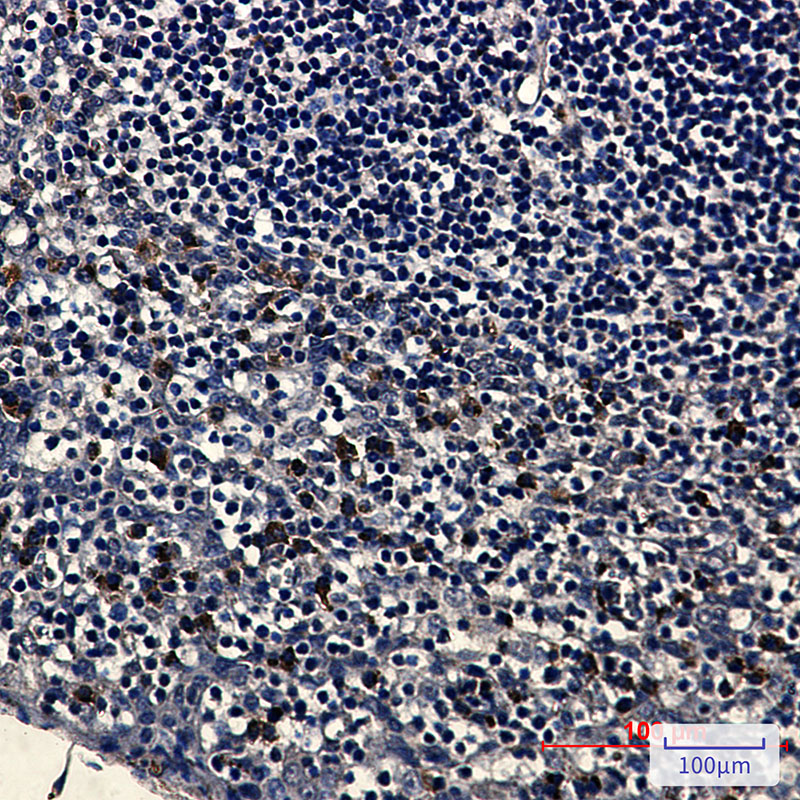


| WB | 1/500-1/1000 | Human,Mouse,Rat |
| IF | 咨询技术 | Human,Mouse,Rat |
| IHC | 1/50-1/100 | Human,Mouse,Rat |
| ICC | 1/50-1/200 | Human,Mouse,Rat |
| FCM | 咨询技术 | Human,Mouse,Rat |
| Elisa | 咨询技术 | Human,Mouse,Rat |
| Aliases | HCAK1; Ig kappa chain C region; IGKC; IMMUNOGLOBULIN InV; Km |
| Entrez GeneID | 3514 |
| WB Predicted band size | Calculated MW: 12 kDa; Observed MW: 26 kDa |
| Host/Isotype | Rabbit IgG |
| Antibody Type | Primary antibody |
| Storage | Store at 4°C short term. Aliquot and store at -20°C long term. Avoid freeze/thaw cycles. |
| Species Reactivity | Human |
| Immunogen | A synthesized peptide derived from human Human Kappa Chain |
| Formulation | Purified antibody in TBS with 0.05% sodium azide,0.05%BSA and 50% glycerol. |
+ +
以下是3篇关于人类κ轻链抗体的经典文献及其概要:
1. **"Structural basis for the diversity of the immunoglobulin light chain"**
- 作者:Al-Lazikani, B. et al. (1997)
- 摘要:通过X射线晶体学分析κ轻链可变区的结构,揭示了其与抗原结合多样性相关的构象变化及互补决定区(CDR)的分子机制。
2. **"Human monoclonal IgGκ autoantibodies from patients with monoclonal gammopathy"**
- 作者:Solomon, A. et al. (1983)
- 摘要:研究了多发性骨髓瘤患者中单克隆κ轻链抗体的病理特征,发现其异常折叠倾向导致淀粉样蛋白沉积,为临床诊断提供生物标志物依据。
3. **"κ Light chains are essential for the expression of autoreactive antibodies in systemic lupus erythematosus"**
- 作者:Wellmann, U. et al. (2005)
- 摘要:通过基因敲除小鼠模型证明,κ轻链在系统性红斑狼疮(SLE)中驱动自身抗体的形成,其异常重组与免疫复合物介导的器官损伤相关。
4. **"Antibody light chain variable regions and their genes"**
- 作者:Hozumi, N. & Tonegawa, S. (1976)
- 摘要:早期研究揭示了κ轻链基因的V-J重组机制,阐明了抗体多样性产生的遗传学基础,奠定抗体工程的理论框架。
以上文献涵盖结构生物学、临床病理学、自身免疫机制及遗传学领域,均为领域内奠基性研究。
Human kappa light chain antibodies are a critical component of immunoglobulin molecules, contributing to antigen recognition in the adaptive immune system. In humans, antibody light chains exist in two isoforms: kappa (κ) and lambda (λ), encoded by distinct gene loci on chromosomes 2 and 22. respectively. Approximately 60% of circulating antibodies in healthy individuals contain kappa light chains, while lambda chains account for the remaining 40%. Each antibody consists of two identical heavy chains paired with two identical light chains (either κ or λ), forming a Y-shaped structure. The kappa light chain comprises a variable (V) region, responsible for antigen binding specificity through complementarity-determining regions (CDRs), and a constant (C) region that stabilizes the immunoglobulin structure.
The production of kappa light chains occurs during B cell maturation in the bone marrow, where V(D)J recombination generates diverse antigen-binding sites. This genetic diversity, combined with somatic hypermutation, enables broad immune recognition. Clinically, the detection of kappa light chains has diagnostic significance. Monoclonal proliferation of kappa chains (e.g., in multiple myeloma or B cell lymphomas) results in an imbalanced κ:λ ratio, which is measurable via serum free light chain (sFLC) assays or immunohistochemistry. Polyclonal increases may indicate inflammatory conditions. Additionally, kappa light chains are used as biomarkers to monitor treatment response and disease recurrence in plasma cell disorders. Their stability and specificity also make them valuable tools in research and therapeutic applications, such as antibody engineering and targeted drug delivery systems.
×